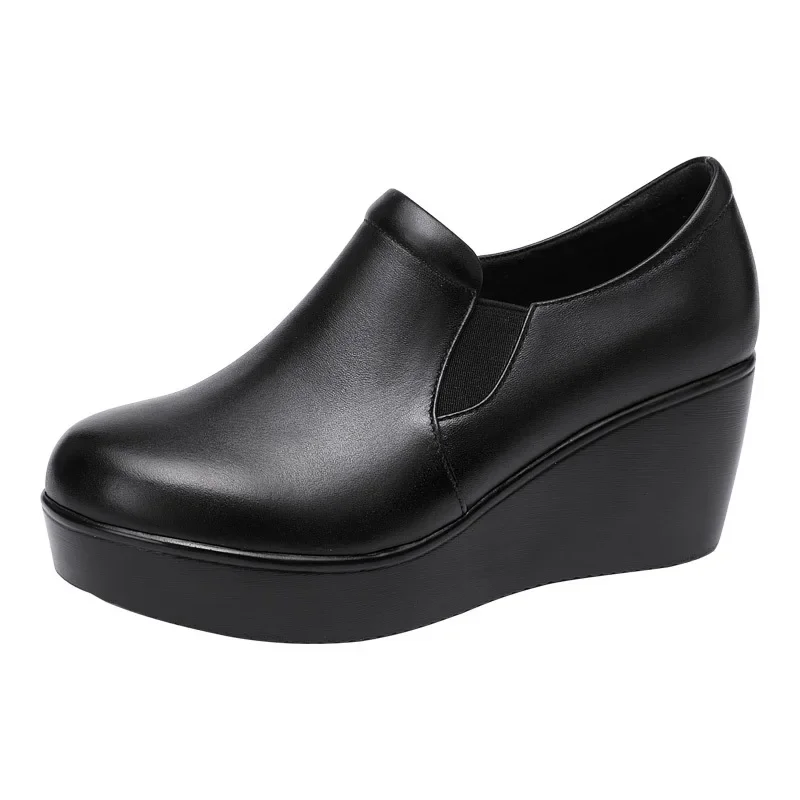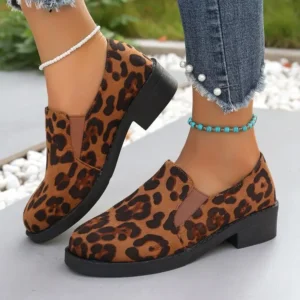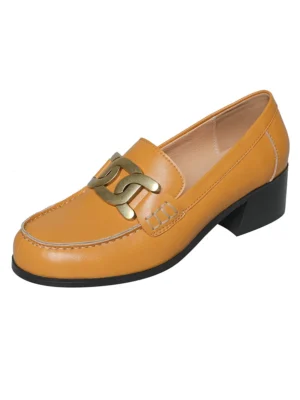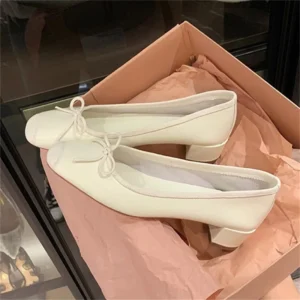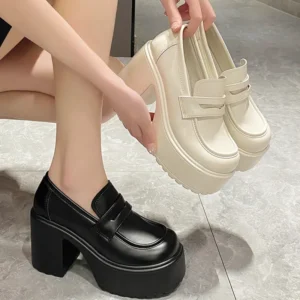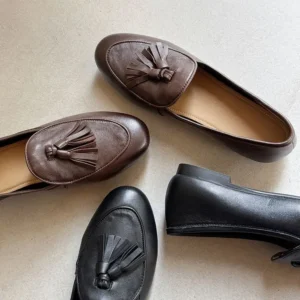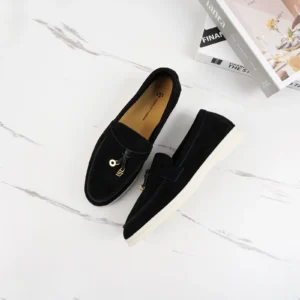Introduction: The Renaissance of the Loafer
Contemporary loafers represent a bold reimagining of one of footwear’s most enduring classics. Unlike their traditional counterparts—characterized by simple leather construction, minimal ornamentation, and conservative silhouettes—modern loafers incorporate innovative materials, experimental shapes, and design elements that push the boundaries of this once-conservative shoe category.
In today’s fashion landscape, loafers have evolved from purely practical slip-ons to versatile statement pieces. What began as casual boating shoes in the early 20th century has undergone a remarkable transformation, with designers reinterpreting and reinventing modern loafer design evolution through innovative materials, unexpected proportions, and fresh styling approaches.
The luxury footwear market has responded enthusiastically to this renaissance, with premium loafers experiencing a 15% growth rate in recent years—outpacing many other footwear categories. This surge reflects how contemporary loafers have successfully balanced heritage appeal with forward-thinking design elements.
Throughout this article, we’ll explore the key elements that define today’s square toe loafers and modern looks, from innovative sole constructions and silhouette transformations to material breakthroughs and decorative approaches that signal this classic’s evolution into something entirely new.
I. Foundation Reimagined: Innovative Sole Designs
The most immediately noticeable difference between traditional and contemporary loafers often lies beneath the foot. Modern sole designs serve as both functional foundations and bold style statements, dramatically altering the shoe’s overall silhouette, weight, and proportions. These reimagined foundations represent a fundamental departure from the whisper-thin leather soles that characterized classic penny loafers for decades.
Today’s designers approach sole construction as an opportunity for creative expression rather than merely a functional necessity. This shift has produced a remarkable variety of interpretations—from chunky, sculptural platforms to ultra-sleek, minimalist designs that prioritize flexibility and lightweight comfort.
The innovation in sole design has technical advantages beyond aesthetics. Modern materials provide improved cushioning, shock absorption, and durability that traditional leather soles simply cannot match. Many contemporary women’s platform chunky loafers feature multi-layer constructions that combine visual impact with practical benefits for all-day wear.
A. The Rise of Chunky Soles
Perhaps no trend better exemplifies contemporary loafer evolution than the dramatic rise of chunky, substantial soles. These bold foundations typically feature:
- Track soles with deep treads and pronounced lugs, adding 1-2 inches of height
- Platform constructions that maintain a relatively flat profile while elevating the entire foot
- Hybrid designs incorporating elements from combat boots and outdoor footwear
- Contrasting materials and colors that highlight the exaggerated proportions
The practical benefits of these substantial designs include improved traction, greater durability in wet conditions, and added height without the discomfort of a traditional heel. Aesthetically, chunky lug sole loafers create a bold silhouette that transforms the traditional loafer’s conservative image into something deliberately fashion-forward.
B. Minimalist and Sleek Approaches
At the opposite end of the design spectrum, some contemporary designers have embraced ultra-thin, flexible soles that prioritize a sleek, refined aesthetic. These minimalist interpretations often feature:
- Micro-rubber soles measuring just 3-5mm in thickness
- Flexible constructions that allow the shoe to bend and move naturally
- Lightweight materials that reduce overall weight by up to 40% compared to traditional designs
- Clean, uninterrupted lines that create an elegant profile
These minimalist approaches connect to the broader “quiet luxury” trend, where subtlety and restrained design signal sophistication. Technical innovations in materials science have enabled these ultra-thin profiles while maintaining necessary durability and support—something impossible with traditional manufacturing methods.
C. Hybrid Constructions
Many contemporary loafers defy easy categorization by blending elements from athletic footwear, casual shoes, and traditional dress designs. These hybrid constructions feature:
- Sneaker-inspired cushioned midsoles paired with traditional loafer uppers
- Performance materials like EVA and memory foam integrated into classic silhouettes
- Flexible constructions that combine formal appearances with casual comfort
- Multi-density sole designs that optimize both stability and cushioning
These cross-category designs reflect broader fashion movements that blur the lines between formal and casual, creating versatile footwear that functions across various settings and dress codes.
II. Silhouette Evolution: Contemporary Shapes and Forms
Beyond sole construction, the overall silhouette and form of loafers have undergone dramatic reinterpretation. Contemporary designs play with proportions, toe shapes, and structural elements to create forms that reference tradition while establishing distinctly modern identities.
Modern loafer silhouettes often feature exaggerated proportions that draw attention to specific design elements. Whether elongating the toe, increasing the vamp height, or playing with asymmetrical shapes, these design choices create visual interest and signal a departure from conventional approaches.
What makes contemporary silhouettes particularly interesting is how they maintain just enough traditional loafer DNA to remain recognizable while pushing boundaries in unexpected directions. Understanding the relationship between square toe vs round toe fashion helps explain how small changes in silhouette can dramatically alter a shoe’s character and style classification.
A. Modern Toe Shapes
Toe shape serves as one of the most definitive elements in contemporary loafer design, with modern interpretations departing significantly from the rounded toe of classic penny loafers:
- Square and rectangular toes have emerged as bold statements, creating geometric silhouettes that feel deliberately modern
- Elongated almond shapes balance contemporary styling with wearable proportions
- Exaggerated pointed toes extend the visual line of the shoe by up to an inch longer than traditional designs
- Asymmetrical toe shapes that create unique visual interest from different angles
These reimagined toe shapes dramatically influence how the entire shoe is perceived, with women’s square toe flat loafers offering a particularly architectural and contemporary aesthetic that pairs beautifully with modern clothing silhouettes.
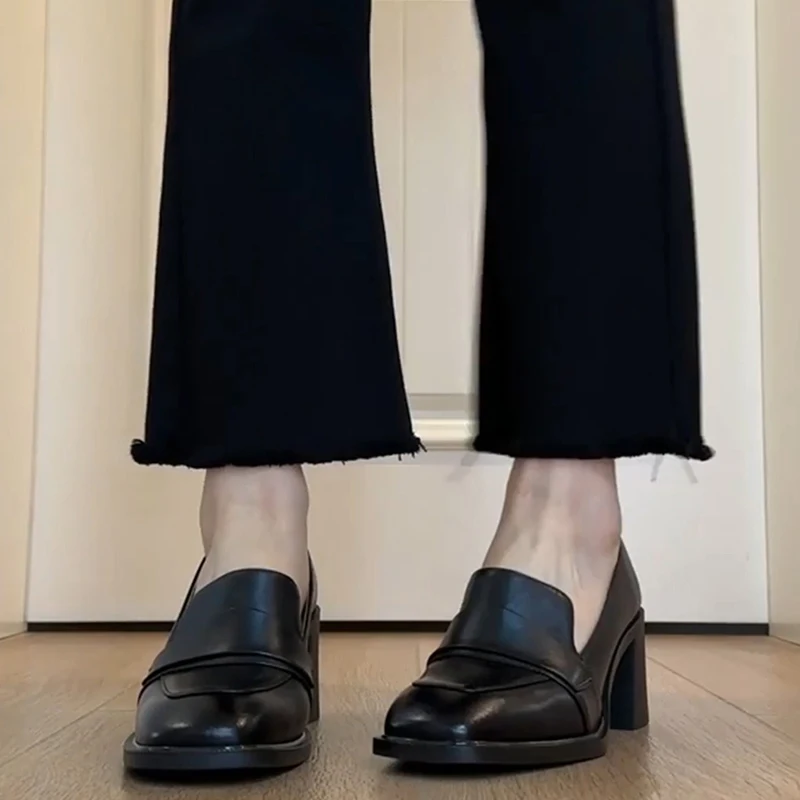
B. Deconstructed and Fluid Forms
Many contemporary designers have embraced softer, more relaxed constructions that contrast with the rigid structure of traditional loafers:
- Collapsible heel counters that allow the shoe to be worn folded down as a slide
- Unstructured vamps that mold to the foot rather than maintaining a fixed shape
- Softer leather constructions that prioritize flexibility and comfort
- Elimination of traditional internal stiffeners and support structures
These deconstructed approaches reflect broader fashion movements toward comfort and fluid forms. By removing rigid elements and embracing natural movement, these designs create a more casual, lived-in aesthetic that appeals to contemporary sensibilities while maintaining the loafer’s essential character.
C. Backless Designs and Modern Variations
Perhaps the most radical silhouette evolution comes in the form of backless variations that transform the traditional closed loafer into a slip-on mule:
- Open-back designs that maintain the loafer’s distinctive front while eliminating the heel counter
- Varied heel heights ranging from completely flat to 2-inch block heels
- Collapsible designs that can be worn either as traditional loafers or as slides
- Exaggerated proportions that emphasize the mule silhouette through extended vamps
These women’s loafer mules represent a perfect marriage of classic loafer elements with contemporary convenience and styling flexibility. The backless construction creates a more casual, effortless aesthetic that aligns with modern dressing preferences while referencing the loafer’s heritage.
III. Material Innovations: Beyond Traditional Leathers
Contemporary loafer design extends well beyond form and structure into a radical expansion of materials. While traditional loafers were almost exclusively crafted from smooth calfskin or cordovan leather, modern interpretations embrace an unprecedented variety of materials, textures, and finishes.
This material revolution serves multiple purposes—it creates visual and tactile interest, improves performance characteristics, addresses sustainability concerns, and allows for greater seasonality in what was once considered year-round footwear. Understanding the relationship between materials and footwear design comfort has enabled designers to create contemporary loafers that excel in both form and function.
A. Luxury and Statement Leathers
Contemporary designers have reimagined how leather is used in loafer construction:
- High-gloss patent finishes create mirror-like surfaces that transform classic silhouettes
- Embossed leathers with crocodile, lizard, and other exotic textures add visual complexity
- Metallic and iridescent finishes create eye-catching light effects and color-shifting properties
- Butter-soft nappa and deerskin leathers prioritize flexibility and comfort
These premium leather treatments serve as the primary design element in many contemporary loafers, transforming familiar shapes into statement pieces through finish alone. The women’s metallic loafers in gold and silver particularly exemplify how material choices can elevate and modernize a classic silhouette.
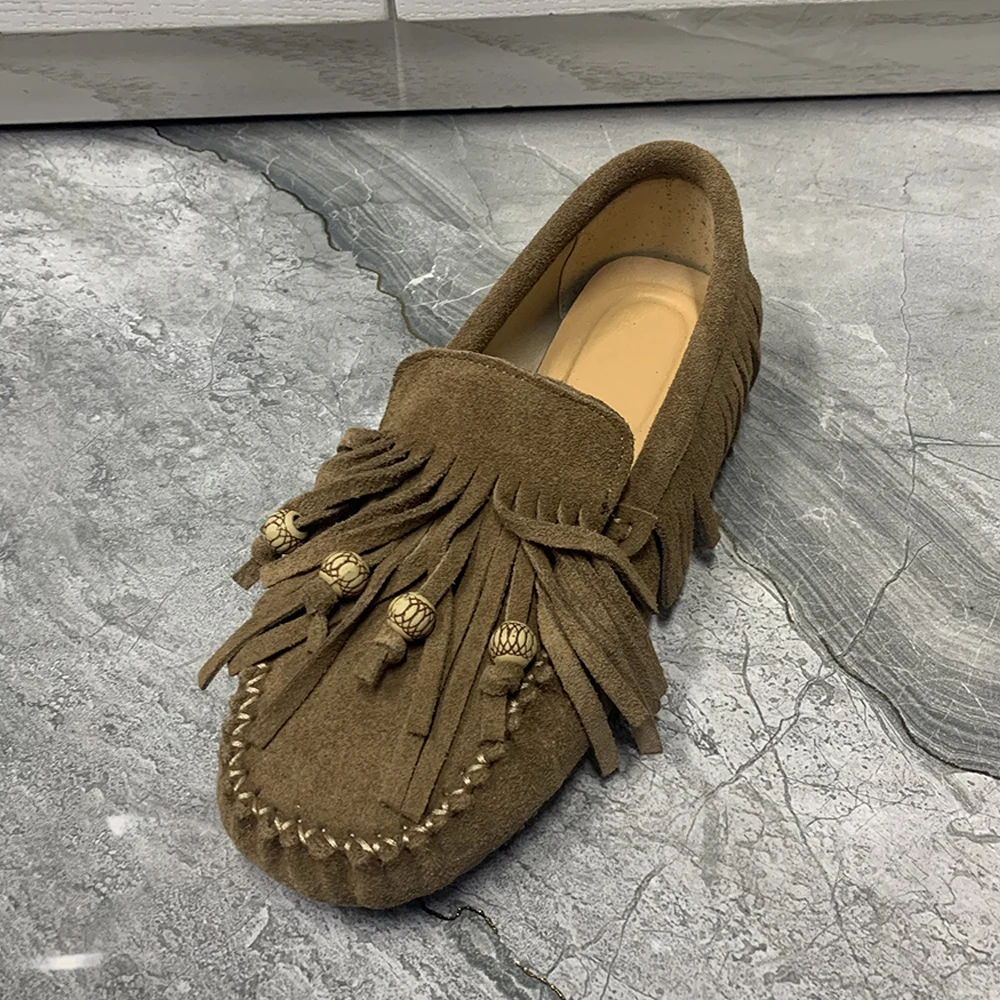
B. Sustainable and Innovative Alternatives
As sustainability concerns influence fashion at all levels, contemporary loafer design has embraced alternative materials with reduced environmental impacts:
- Plant-based leather alternatives derived from apple, pineapple, and mushroom fibers
- Recycled materials repurposed from post-consumer and industrial waste
- Bio-based polymers that reduce reliance on petroleum derivatives
- Ethical and transparent sourcing of traditional materials
These sustainable innovations are particularly noteworthy for achieving luxury aesthetics and performance without traditional resource-intensive materials. Many premium brands now offer these alternatives not as compromises but as design features worthy of highlighting.
C. Textile and Technical Materials
Contemporary loafers frequently incorporate textiles and technical materials rarely seen in traditional footwear construction:
- Performance knits that offer breathability and stretch
- Technical meshes providing lightweight structure and ventilation
- Seasonal natural fibers like raffia, linen, and canvas
- Weatherproof membranes and coatings that improve functionality
These material choices often bring performance benefits from athletic and outdoor categories into the dress shoe space. By incorporating technical textiles, contemporary loafers achieve comfort, breathability, and versatility impossible with traditional constructions.
IV. Decorative Elements: Hardware and Embellishments
The decorative elements that adorn contemporary loafers represent a fascinating balance between tradition and innovation. While classic loafers featured minimal ornamentation—perhaps a simple penny strap or tassel—modern interpretations use hardware, embellishments, and decorative techniques as central design features.
These contemporary decorative approaches range from dramatically oversized traditional elements to completely novel adornments with no historical precedent in loafer design. Finding the best square toe loafers often involves evaluating how these decorative elements integrate with the overall design while maintaining a cohesive aesthetic.
A. Modernized Hardware
Traditional loafer hardware has been reimagined through contemporary proportions and finishes:
- Classic horsebit details scaled up to 2-3 times traditional size
- Chunky chain embellishments across the vamp
- Minimal metal bars and geometric elements
- Brand-specific hardware that serves as a recognizable signature
These modern hardware applications transform functional elements into bold focal points. By playing with scale, material, and placement, designers create distinctive variations that reference tradition while establishing contemporary identity.
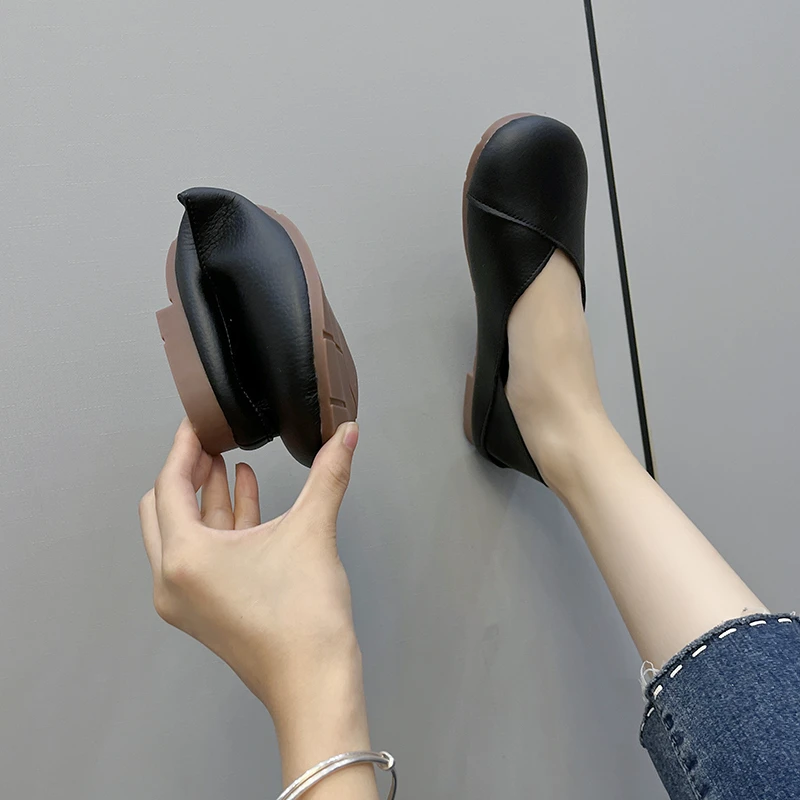
B. Decorative Stitching and Details
Contemporary loafer design often features stitching and construction details elevated from functional necessity to decorative statement:
- Contrast stitching in bold colors highlighting construction lines
- Reimagined tassel detail loafers with exaggerated or miniaturized proportions
- Decorative perforations creating patterns and texture
- Whipstitching, hand-sewn details, and artisanal finishing techniques
These details serve dual purposes—they showcase craftsmanship while creating visual interest through texture, pattern, and color contrast. The deliberate visibility of construction elements reflects broader fashion trends that highlight rather than conceal how garments and accessories are made.
C. Minimalism and Absence of Decoration
Paradoxically, some of the most distinctively contemporary loafer designs are defined by the complete absence of traditional decorative elements:
- Clean, uninterrupted vamps with no hardware or ornamentation
- Hidden construction details that create seamless appearances
- Subtle texture variations as the only visual interest
- Focus on form, proportion, and silhouette rather than applied decoration
This minimalist approach represents a significant departure from both traditional and other contemporary approaches. By stripping away expected elements, these designs achieve a modern sophistication through restraint rather than embellishment.
V. Color Palettes and Finishes in Modern Designs
Color choice serves as one of the most immediate signals of contemporary design in loafers. While traditional styles remained firmly within a narrow range of browns and blacks, modern interpretations embrace an expansive palette that includes everything from soft neutrals to vivid brights.
The square toe loafer styling guide demonstrates how contemporary color choices can dramatically affect versatility and styling options. Modern finishes further transform familiar silhouettes by altering how materials catch light, creating depth, and establishing distinct seasonal identities.
A. New Neutrals
Contemporary loafer design has redefined what constitutes a “neutral” shade:
- Winter white and ivory tones worn year-round rather than seasonally
- Soft taupe, mushroom, and stone shades replacing traditional medium browns
- Pale blush and beige tones functioning as versatile foundations
- Cool gray tones offering alternatives to conventional black
These new neutrals provide versatility while signaling contemporary taste. Their subtle departure from traditional shades creates a modern aesthetic without sacrificing the pairing flexibility that makes neutral footwear so practical.
B. Statement Colors and Finishes
Bold color choices transform familiar silhouette into distinctive fashion statements:
- Saturated jewel tones like emerald, sapphire, and ruby
- Vibrant primary colors creating strong visual impact
- Metallic finishes in gold, silver, bronze, and iridescent variations
- Color-shifting finishes that change appearance depending on lighting and angle
These statement colors reflect fashion’s increased comfort with bold footwear as a central outfit element rather than a subtle complement. Contemporary loafers in these finishes often serve as the focal point around which entire outfits are built.
C. Pattern and Texture as Design Elements
Contemporary loafer design frequently employs pattern to create visual interest:
- Classic animal prints reinterpreted through modern color combinations
- Textural variations creating subtle pattern effects
- Color-blocking techniques dividing the shoe into distinct zones
- Embossed patterns creating dimensional surface interest
Leopard print loafers exemplify how traditional patterns can be reinterpreted through contemporary proportions and color combinations. These patterned approaches add visual complexity while maintaining the versatility that makes loafers such enduring wardrobe components.
VI. The Context of Contemporary Design: Cultural Influences
Contemporary loafer design doesn’t exist in isolation—it reflects broader cultural movements, changing lifestyle needs, and evolving fashion sensibilities. Understanding these contextual factors helps explain why certain design elements have gained prominence and how they connect to larger trends beyond footwear.
The enduring appeal of classic loafer design provides an essential foundation for understanding these contemporary innovations. By recognizing what has remained constant amid dramatic evolution, we can better appreciate both the heritage influences and the boundary-pushing departures.
A. Comfort Revolution and Functional Design
Perhaps no factor has influenced contemporary loafer design more than the widespread prioritization of comfort:
- Ergonomic footbeds with anatomical support features
- Flexible constructions that move naturally with the foot
- Cushioned insoles incorporating foam technologies from athletic footwear
- Weight reduction through innovative materials and construction techniques
This comfort revolution reflects changing consumer expectations—today’s luxury customer demands both sophisticated aesthetics and all-day wearability. Contemporary designers have responded by integrating comfort technologies invisibly without compromising the clean lines and elegant proportions that define modern loafer design.
Women's Comfortable Flat Loafers, Women's Leopard Print Loafers, Women's Low Heel Loafers
$82.50 Select options This product has multiple variants. The options may be chosen on the product pageWomen's Block Heel Loafers, Women's Heeled Penny Loafers, Women's Monk Strap Loafers
$194.04 Select options This product has multiple variants. The options may be chosen on the product pageWomen's Block Heel Loafers, Women's Square Heel Loafers, Women's Square Toe Flat Loafers
Price range: $73.61 through $86.41 Select options This product has multiple variants. The options may be chosen on the product pageWomen's Black Platform Loafers, Women's High Heel Loafers, Women's High Platform Loafers, Women's White Platform Loafers
$106.67 Select options This product has multiple variants. The options may be chosen on the product pageWomen's Black Flat Loafers, Women's Black Penny Loafers, Women's Classic Tassel Loafers
$194.28 Select options This product has multiple variants. The options may be chosen on the product pageWomen's Loafer Mules, Women's Suede Flat Loafers
$190.23 Select options This product has multiple variants. The options may be chosen on the product page
B. Gender-Fluid Approaches
Contemporary loafer design increasingly transcends traditional gender distinctions:
- Expanded size ranges accommodating diverse foot dimensions
- Silhouettes that draw from both men’s and women’s design traditions
- Marketing and styling that avoids rigid gender categorization
- Design elements that blend traditionally masculine and feminine codes
This more fluid approach reflects broader cultural shifts away from rigid gender definitions. Today’s most innovative loafer designs often exist in a versatile middle ground, appealing across traditional gender boundaries through proportion, material, and styling choices that prioritize design integrity over conventional categorization.
C. Balancing Innovation with Heritage
The most successful contemporary loafer designs maintain a thoughtful dialogue between innovation and heritage:
- References to archival elements reinterpreted through modern proportions
- Respect for traditional construction methods while embracing new materials
- Preservation of key identifying features while reimagining overall aesthetics
- Craftsmanship values maintained despite technological advances
This balance ensures that contemporary loafers remain connected to their rich heritage while evolving to meet current aesthetic preferences and functional requirements. The tension between tradition and innovation creates a productive creative space where designers can honor the past while advancing the category into the future.
VII. Selecting Contemporary Loafers: A Practical Guide
With so many design variations available, selecting contemporary loafers that balance fashion-forward design with practical wearability requires thoughtful consideration. Quality indicators, styling versatility, and personal comfort preferences should guide these investment purchases.
At Artisan Haul, we’ve observed that the most successful contemporary loafer purchases combine distinctive design elements with thoughtful construction and material choices. This balance ensures both immediate satisfaction and long-term wearability as styles evolve.
A. Evaluating Quality and Craftsmanship
Even the most innovative designs require quality foundations to deliver lasting value:
- Examine sole attachment methods—Goodyear welting and Blake stitching typically indicate quality construction
- Assess material quality through texture, finish consistency, and edge treatments
- Look for clean interior finishing without rough edges or exposed adhesives
- Test flexibility and weight to ensure comfort aligns with visual appeal
- Verify that decorative elements are securely attached and cleanly finished
These quality indicators remain relevant across both traditional and contemporary designs. While aesthetic preferences are subjective, construction quality provides objective criteria for evaluating investment-worthy loafers regardless of design approach.
B. Styling Contemporary Loafers
Contemporary loafers offer exceptional styling versatility across different contexts:
- Chunky-soled versions pair beautifully with cropped pants and voluminous silhouettes
- Sleek minimalist designs complement tailored pieces and streamlined proportions
- Statement colors and materials work best as focal points with otherwise simple outfits
- Consider proportions—chunky loafers balance oversized clothing while slim designs complement fitted silhouettes
This versatility represents one of contemporary loafers’ greatest strengths. By selecting designs that complement your wardrobe’s overall aesthetic, you ensure these investment pieces integrate seamlessly into multiple outfits across various contexts.
VIII. Future Directions: Emerging Loafer Design Trends
As loafer design continues evolving, several emerging directions suggest where this footwear category might head next:
- Increased material experimentation with bio-engineered alternatives
- Technology integration through smart materials and adaptive components
- Further blurring of casual and formal design elements
- Customization opportunities allowing personal expression within established frameworks
These future directions will likely continue the balancing act between innovation and heritage that has characterized the most successful contemporary loafer designs. The enduring appeal of this footwear category lies precisely in this tension—how it maintains recognizable connections to tradition while constantly reinventing itself through fresh design approaches.
As consumers increasingly prioritize both distinctive design and practical wearability, contemporary loafers are uniquely positioned to meet these seemingly contradictory demands. By understanding the design elements that define modern interpretations, you can make more informed choices about which innovations best align with your personal style and functional needs.

